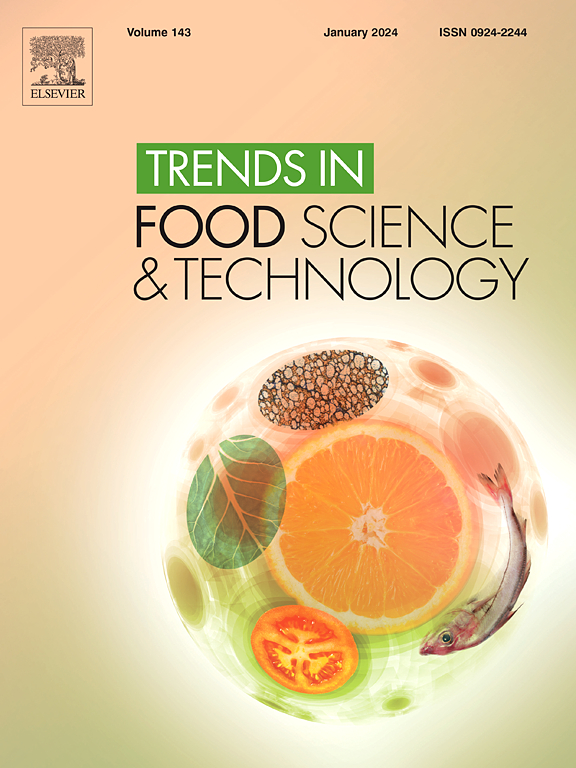Size reduction and particle size influence the quantification of phenolic-type compounds and antioxidant activity in plant food matrices
IF 15.1
1区 农林科学
Q1 FOOD SCIENCE & TECHNOLOGY
引用次数: 0
Abstract
Background
Particle size reduction is a critical step in analytical methods used to evaluate bioactive compounds and antioxidant activity in plant foods. In laboratory assays, reducing particle size enhances the efficiency of solvent extraction, which is essential for accurately quantifying and identifying target bioactive compounds. However, many current analytical methodologies fail to report detailed size reduction processes, leading to inconsistent particle sizes and potentially unreliable results. This lack of standardization may significantly impact the extraction process, as inadequate particle reduction can limit solvent access to target molecules, ultimately affecting both the bioavailability and bioactivity of the compounds under study.
Scope and approach
This article examines the crucial role of particle size reduction in analytical methods for evaluating bioactive compounds and antioxidant activity in plant food matrices. It explores the fundamental principles of particle size reduction and solid-liquid extraction, emphasizing the influence of the plant's cellular matrix on these processes. Given that variability in analytical outcomes may arise from inefficient extraction due to particle size differences, we argue that inconsistencies in reporting can lead to inaccurate conclusions about the potential health benefits of plant-based bioactive compounds. To enhance reliability, we suggest that methodologies for quantifying phenolic compounds and antioxidant activity should include specific particle size parameters to ensure comparability and reproducibility of results.
Key findings and conclusions
By reviewing existing literature, we illustrate the significant impact of particle size on analytical accuracy and the interpretation of health-related data. Studies that fail to control or report particle size variation may introduce errors in bioactive compound quantification, leading to misleading conclusions about their health-promoting properties. Standardizing particle size reduction protocols in analytical methods can improve the consistency and reliability of research findings, ultimately strengthening the scientific basis for understanding the role of plant-based bioactive compounds in human health.
植物食物基质中酚类化合物的定量和抗氧化活性受粒径和粒径的影响
在评估植物性食品中生物活性化合物和抗氧化活性的分析方法中,减小颗粒尺寸是一个关键步骤。在实验室分析中,减小颗粒大小可以提高溶剂萃取的效率,这对于准确定量和识别目标生物活性化合物至关重要。然而,许多当前的分析方法未能报告详细的尺寸减小过程,导致颗粒尺寸不一致和潜在的不可靠的结果。这种缺乏标准化可能会严重影响提取过程,因为颗粒还原不足会限制溶剂接近目标分子,最终影响所研究化合物的生物利用度和生物活性。本文探讨了在植物性食物基质中评估生物活性化合物和抗氧化活性的分析方法中,颗粒大小的减小所起的关键作用。它探讨了颗粒大小减少和固液萃取的基本原理,强调了植物的细胞基质对这些过程的影响。鉴于分析结果的可变性可能是由于颗粒大小差异导致的低效率提取引起的,我们认为报告的不一致可能导致关于植物性生物活性化合物潜在健康益处的不准确结论。为了提高可靠性,我们建议定量酚类化合物和抗氧化活性的方法应该包括特定的粒径参数,以确保结果的可比性和可重复性。主要发现和结论通过回顾现有文献,我们说明了颗粒大小对分析准确性和健康相关数据解释的重要影响。未能控制或报告颗粒大小变化的研究可能会在生物活性化合物的定量中引入错误,从而导致对其促进健康特性的误导性结论。将分析方法中的粒度减小方案标准化可以提高研究结果的一致性和可靠性,最终加强理解植物性生物活性化合物对人类健康的作用的科学基础。
本文章由计算机程序翻译,如有差异,请以英文原文为准。
求助全文
约1分钟内获得全文
求助全文
来源期刊

Trends in Food Science & Technology
工程技术-食品科技
CiteScore
32.50
自引率
2.60%
发文量
322
审稿时长
37 days
期刊介绍:
Trends in Food Science & Technology is a prestigious international journal that specializes in peer-reviewed articles covering the latest advancements in technology, food science, and human nutrition. It serves as a bridge between specialized primary journals and general trade magazines, providing readable and scientifically rigorous reviews and commentaries on current research developments and their potential applications in the food industry.
Unlike traditional journals, Trends in Food Science & Technology does not publish original research papers. Instead, it focuses on critical and comprehensive reviews to offer valuable insights for professionals in the field. By bringing together cutting-edge research and industry applications, this journal plays a vital role in disseminating knowledge and facilitating advancements in the food science and technology sector.
 求助内容:
求助内容: 应助结果提醒方式:
应助结果提醒方式:


